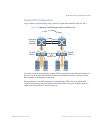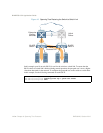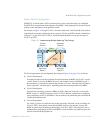
BLADEOS 6.5.2 Application Guide
120 Chapter 8: Spanning Tree Protocols BMD00220, October 2010
Adding and Removing Ports from STGs
When you add a port to a VLAN that belongs to an STG, the port is also added to that STG.
However, if the port you are adding is an untagged port and is already a member of another
STG, that port will be removed from its current STG and added to the new STG. An untagged
port cannot belong to more that one STG.
For example: Assume that VLAN 1 belongs to STG 1, and that port 1 is untagged and does not
belong to any STG. When you add port 1 to VLAN 1, port 1 will automatically become part of
STG 1.
However, if port 5 is untagged and is a member of VLAN 3 in STG 2, then adding port 5 to
VLAN 1 in STG 1 will change the port PVID from 3 to 1:
When you remove a port from VLAN that belongs to an STG, that port will also be removed
from the STG. However, if that port belongs to another VLAN in the same STG, the port
remains in the STG.
As an example, assume that port 2 belongs to only VLAN 2, and that VLAN 2 belongs to STG
2. When you remove port 2 from VLAN 2, the port is moved to default VLAN 1 and is
removed from STG 2.
However, if port 2 belongs to both VLAN 1 and VLAN 2, and both VLANs belong to STG 2,
removing port 2 from VLAN 2 does not remove port 2 from STG 1, because the port is still a
member of VLAN 1, which is still a member of STG 1.
An STG cannot be deleted, only disabled. If you disable the STG while it still contains VLAN
members, Spanning Tree will be off on all ports belonging to that VLAN.
The relationship between port, trunk groups, VLANs, and Spanning Trees is shown in Table 11 on
page 111.
"Port 5 is an UNTAGGED port and its PVID changed from 3 to 1.


















